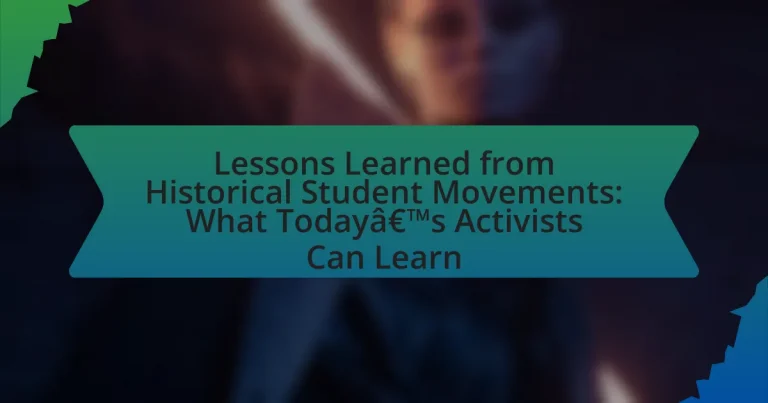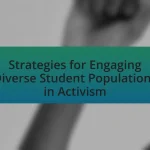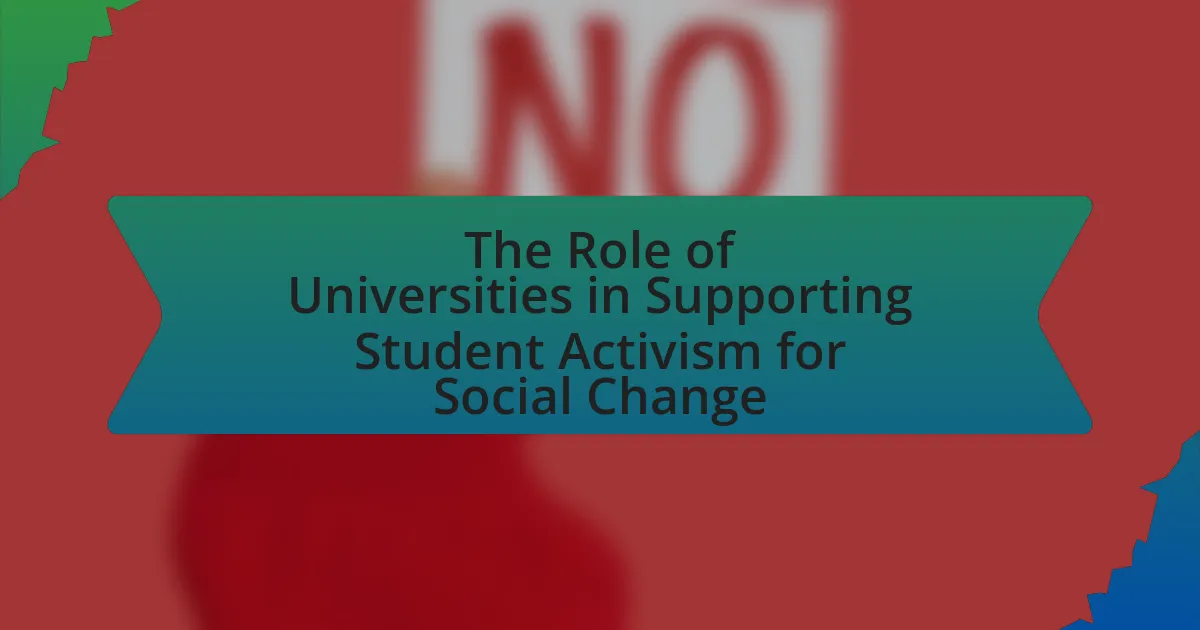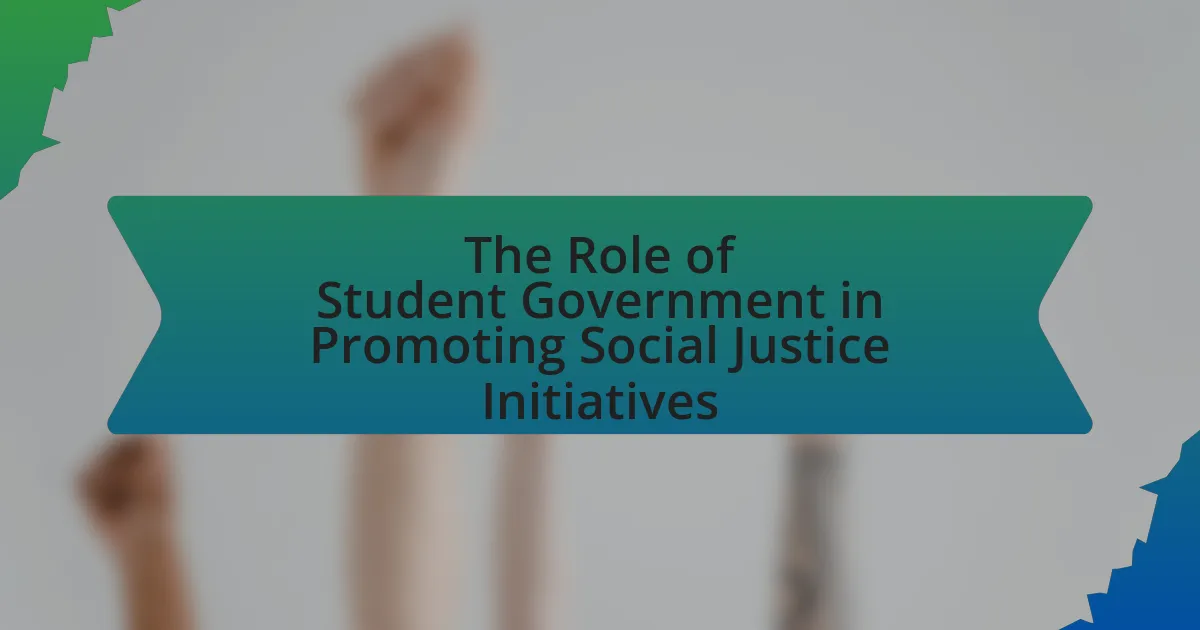The article examines the lessons learned from historical student movements and their relevance for contemporary activists. It highlights key movements such as the Civil Rights Movement, anti-Vietnam War protests, and significant events like the Kent State shootings and Tiananmen Square protests, illustrating how organized student activism has influenced social change and policy reforms. The discussion includes effective strategies employed by past movements, the role of technology and media in amplifying voices, and the importance of inclusivity and coalition-building. Additionally, it addresses common pitfalls to avoid and best practices for modern activism, emphasizing the value of historical insights in shaping current efforts for social justice and equality.
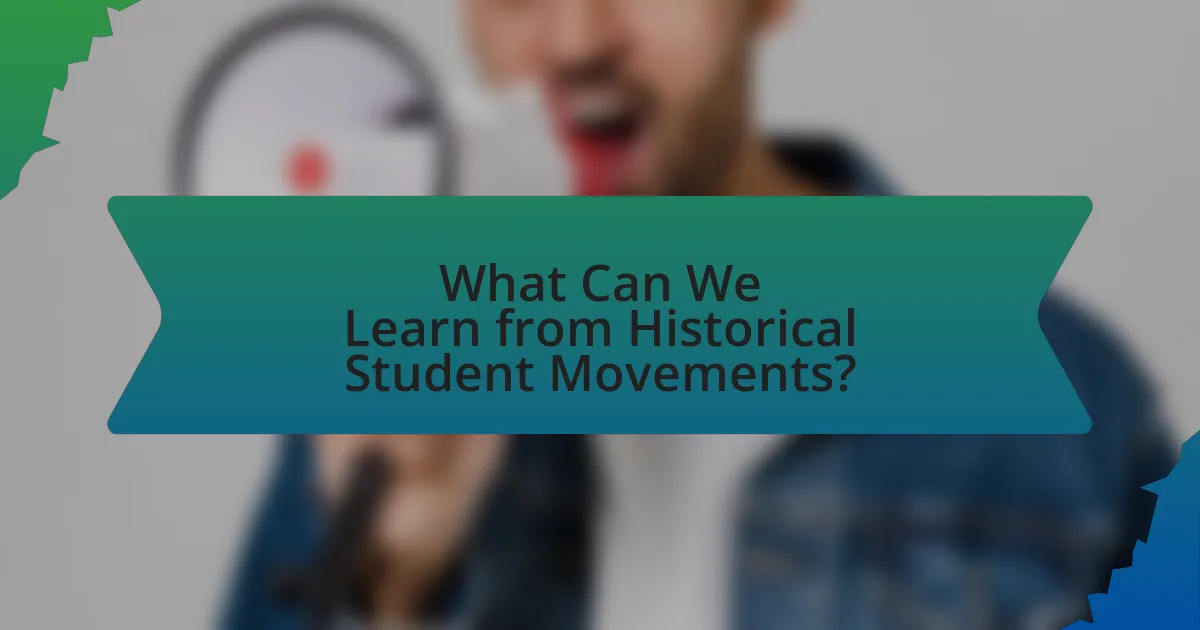
What Can We Learn from Historical Student Movements?
Historical student movements demonstrate the power of collective action in advocating for social change. These movements, such as the 1960s Civil Rights Movement and the anti-Vietnam War protests, illustrate how organized student activism can influence public policy and societal norms. For instance, the 1964 Free Speech Movement at the University of California, Berkeley, successfully challenged restrictions on political activities on campus, leading to broader discussions about free speech rights across the nation. This shows that student movements can effectively mobilize public opinion and create lasting impacts on legislation and cultural attitudes.
How Have Student Movements Shaped Social Change?
Student movements have significantly shaped social change by mobilizing youth to advocate for civil rights, environmental issues, and educational reforms. For instance, the Civil Rights Movement in the 1960s saw students participating in sit-ins and protests, which were pivotal in challenging segregation laws and promoting racial equality. Additionally, the anti-Vietnam War protests led by students in the late 1960s influenced public opinion and policy, ultimately contributing to the U.S. withdrawal from Vietnam. These movements demonstrate that organized student activism can effectively challenge the status quo and drive legislative and societal changes.
What Key Events Marked Significant Student Movements?
Key events that marked significant student movements include the May 1968 protests in France, the Kent State shootings in 1970, and the Tiananmen Square protests in 1989. The May 1968 protests involved widespread demonstrations against capitalism and consumerism, leading to a cultural revolution in France. The Kent State shootings occurred when National Guardsmen killed four students during an anti-Vietnam War protest, igniting national outrage and further protests across the United States. The Tiananmen Square protests were a pro-democracy movement in China that culminated in a violent crackdown by the government, resulting in numerous deaths and international condemnation. These events illustrate the power of student activism in shaping political and social landscapes.
How Did These Movements Influence Policy Changes?
Historical student movements significantly influenced policy changes by mobilizing public opinion and pressuring governments to address social issues. For instance, the 1960s civil rights movement led to the passage of the Civil Rights Act of 1964, which outlawed discrimination based on race, color, religion, sex, or national origin. Similarly, the anti-Vietnam War protests in the United States contributed to a shift in public sentiment, ultimately leading to the withdrawal of U.S. troops from Vietnam in 1973. These movements demonstrated the power of collective action and advocacy, resulting in tangible legislative reforms that reflected the demands of the student activists and their supporters.
Why Are Historical Lessons Important for Today’s Activists?
Historical lessons are important for today’s activists because they provide valuable insights into successful strategies and tactics used in past movements. For instance, the Civil Rights Movement in the United States demonstrated the effectiveness of nonviolent protest and grassroots organizing, which can inform contemporary activism. Additionally, studying historical failures, such as the lack of coalition-building in the anti-Vietnam War protests, highlights the importance of inclusivity and collaboration among diverse groups. These lessons enable activists to avoid repeating mistakes and to adopt proven methods that resonate with current social issues, thereby enhancing their impact and effectiveness.
What Common Themes Emerge from Past Movements?
Common themes that emerge from past movements include the pursuit of social justice, the demand for equality, and the importance of collective action. Historical student movements, such as the Civil Rights Movement in the 1960s and the anti-apartheid struggle in South Africa, illustrate how young activists mobilized to challenge systemic oppression and advocate for marginalized communities. These movements often emphasized the role of education in raising awareness and fostering critical thinking, as seen in the student protests at Tiananmen Square in 1989, where participants sought democratic reforms. Additionally, the use of nonviolent resistance, as exemplified by Mahatma Gandhi’s approach, has been a recurring strategy in various movements, highlighting the effectiveness of peaceful protest in achieving political change.
How Can Understanding History Enhance Current Activism?
Understanding history enhances current activism by providing valuable lessons from past movements, enabling activists to adopt effective strategies and avoid previous mistakes. Historical student movements, such as the 1960s civil rights protests and the anti-Vietnam War demonstrations, illustrate the power of collective action and the importance of clear messaging. For instance, the civil rights movement’s use of nonviolent resistance and grassroots organizing led to significant legislative changes, demonstrating that well-planned strategies can yield tangible results. Additionally, studying the successes and failures of past activism helps current activists recognize the socio-political context in which they operate, allowing them to tailor their approaches to contemporary issues effectively.
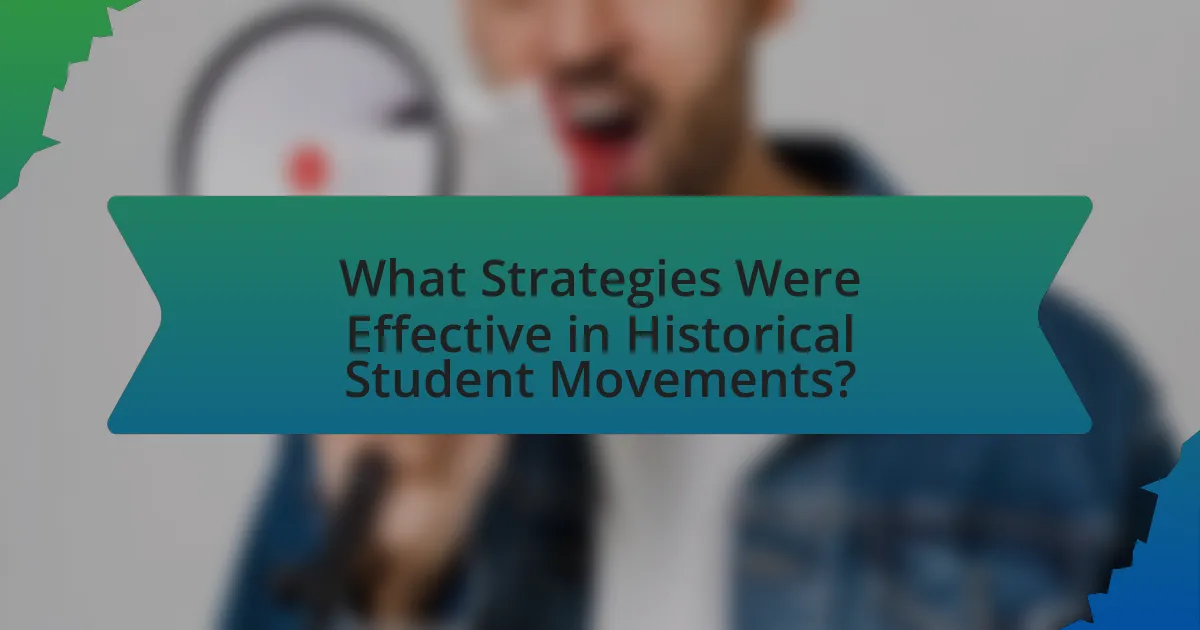
What Strategies Were Effective in Historical Student Movements?
Effective strategies in historical student movements included organized protests, coalition-building, and the use of media to amplify their messages. For instance, during the 1960s Civil Rights Movement, student-led sit-ins and marches were pivotal in challenging segregation, demonstrating the power of direct action. Additionally, the formation of coalitions, such as the Student Nonviolent Coordinating Committee (SNCC), allowed for a unified front that strengthened their impact. The strategic use of media, exemplified by the coverage of the Kent State shootings in 1970, played a crucial role in shaping public opinion and garnering support for student causes. These strategies collectively highlight the importance of organization, collaboration, and communication in achieving social change.
How Did Student Leaders Mobilize Support?
Student leaders mobilized support by organizing grassroots campaigns that engaged their peers and the community. They utilized social media platforms to disseminate information rapidly, creating awareness about their causes and encouraging participation in events. For instance, during the 1960s civil rights movement, student leaders at universities across the United States coordinated sit-ins and protests, effectively rallying thousands of students to join their efforts. This strategic use of communication tools and collective action demonstrated their ability to galvanize support and influence public opinion.
What Communication Tactics Were Used to Engage Peers?
Historical student movements utilized various communication tactics to engage peers, including grassroots organizing, social media campaigns, and public demonstrations. Grassroots organizing involved mobilizing students through face-to-face interactions, fostering a sense of community and shared purpose. Social media campaigns effectively spread awareness and information rapidly, allowing students to connect and coordinate actions on platforms like Twitter and Facebook. Public demonstrations served as visual and impactful expressions of solidarity, drawing attention to causes and encouraging participation. These tactics have been validated by numerous historical examples, such as the 1960s Civil Rights Movement, where coordinated efforts led to significant social change.
How Did Alliances with Other Groups Strengthen Movements?
Alliances with other groups strengthened movements by amplifying their reach and resources, enabling a unified front against common adversaries. For instance, during the Civil Rights Movement, coalitions formed between African American activists and labor unions, which provided financial support and increased visibility. This collaboration led to significant events like the March on Washington in 1963, where diverse groups united to advocate for civil rights, demonstrating that collective action can yield greater impact than isolated efforts. Such alliances often result in shared knowledge, diversified strategies, and enhanced legitimacy, ultimately leading to more effective advocacy and policy changes.
What Role Did Technology Play in Historical Movements?
Technology played a crucial role in historical movements by facilitating communication, organization, and mobilization among activists. For instance, during the Civil Rights Movement in the United States, television broadcasts and print media helped raise awareness of racial injustices, influencing public opinion and garnering support for the cause. Similarly, the use of social media platforms in the Arab Spring allowed for rapid dissemination of information, enabling protesters to coordinate actions and share their experiences globally. These examples illustrate how technology has been instrumental in amplifying voices, spreading messages, and ultimately shaping the outcomes of significant social movements.
How Did Students Utilize Media to Amplify Their Voices?
Students utilized media to amplify their voices by leveraging platforms such as social media, blogs, and traditional news outlets to share their messages and mobilize support. For instance, during the 2018 March for Our Lives movement, students effectively used Twitter and Instagram to organize protests and disseminate information about gun control, reaching millions of people globally. This strategic use of media not only increased visibility for their cause but also engaged a wider audience, demonstrating the power of digital communication in contemporary activism.
What Innovations in Communication Changed the Landscape of Activism?
Innovations in communication that changed the landscape of activism include the internet, social media, and mobile technology. The internet enabled rapid information dissemination and organization of movements, exemplified by the Arab Spring in 2010-2011, where social media platforms like Facebook and Twitter facilitated real-time communication and mobilization. Social media allows activists to reach global audiences, share narratives, and build communities, as seen in movements like Black Lives Matter, which gained traction through hashtags and viral content. Mobile technology further enhances activism by providing tools for on-the-ground coordination and immediate updates, evidenced by the use of apps during protests for organizing and safety. These innovations have fundamentally transformed how activists communicate, organize, and engage with supporters and the public.
How Can Today’s Activists Apply These Lessons?
Today’s activists can apply lessons from historical student movements by prioritizing grassroots organizing and coalition-building. Historical movements, such as the Civil Rights Movement, demonstrated that collective action amplifies voices and creates significant social change. For instance, the Student Nonviolent Coordinating Committee (SNCC) effectively mobilized students across the South, leading to impactful protests and voter registration drives. By fostering inclusive networks and engaging diverse communities, contemporary activists can replicate this success, ensuring broader support and resilience in their campaigns.
What Practical Strategies Can Modern Activists Adopt?
Modern activists can adopt strategies such as leveraging social media for awareness, organizing grassroots campaigns, and forming coalitions with like-minded organizations. Social media platforms have proven effective in mobilizing support and disseminating information rapidly; for instance, the #MeToo movement utilized Twitter to amplify voices and create a global conversation about sexual harassment. Grassroots campaigns enable activists to engage directly with their communities, fostering local support and participation, as seen in the successful mobilization of youth during the 2018 March for Our Lives advocating for gun control. Additionally, forming coalitions allows for resource sharing and increased impact, exemplified by the collaboration between various environmental groups during the Global Climate Strikes, which drew millions of participants worldwide. These strategies demonstrate the effectiveness of modern activism in addressing contemporary issues.
How Can Current Movements Foster Inclusivity and Diversity?
Current movements can foster inclusivity and diversity by actively engaging marginalized communities and amplifying their voices. For instance, movements like Black Lives Matter and rights campaigns have prioritized intersectionality, ensuring that the experiences of various identities are represented and addressed. Research shows that inclusive practices in activism lead to broader support and more effective outcomes, as seen in the increased participation rates among diverse groups in recent protests. By creating spaces for dialogue and collaboration, current movements can dismantle systemic barriers and promote equitable representation, ultimately leading to a more inclusive society.
What Techniques Can Be Used to Sustain Momentum Over Time?
To sustain momentum over time, activists can employ techniques such as consistent communication, strategic goal-setting, and community engagement. Consistent communication keeps supporters informed and motivated, while strategic goal-setting provides clear objectives that can be measured and celebrated, reinforcing commitment. Community engagement fosters a sense of belonging and shared purpose, which is crucial for maintaining enthusiasm and participation. Historical examples, such as the Civil Rights Movement, demonstrate that regular updates and inclusive events helped maintain momentum and adapt to challenges, ensuring sustained activism over years.
What Common Pitfalls Should Today’s Activists Avoid?
Today’s activists should avoid the pitfalls of fragmentation, lack of clear messaging, and neglecting intersectionality. Fragmentation occurs when movements splinter into smaller groups with differing goals, which can dilute their overall impact. For instance, the civil rights movement faced challenges when various factions pursued separate agendas, weakening collective efforts. Clear messaging is crucial; without it, activists risk losing public support and media attention, as seen in the Occupy Wall Street movement, which struggled to articulate specific demands. Lastly, neglecting intersectionality can alienate potential allies; movements that fail to address the interconnectedness of various social issues may overlook the needs of marginalized groups, as highlighted by critiques of early feminist movements that primarily focused on the experiences of white women.
How Can Activists Learn from Past Mistakes?
Activists can learn from past mistakes by analyzing historical movements to identify strategies that failed and understanding the reasons behind those failures. For instance, the anti-Vietnam War protests of the 1960s faced challenges due to a lack of unified messaging and internal divisions, which diluted their impact. By studying these historical examples, current activists can recognize the importance of cohesive communication and solidarity in their efforts. Additionally, reviewing the outcomes of past campaigns, such as the civil rights movement, highlights the effectiveness of strategic planning and grassroots organizing, providing a framework for contemporary activism.
What Warning Signs Indicate Potential Challenges in Movements?
Warning signs that indicate potential challenges in movements include a lack of clear leadership, diminishing public support, and internal divisions among participants. A lack of clear leadership can lead to confusion and ineffective decision-making, as seen in the Occupy Wall Street movement, where decentralized leadership resulted in fragmented goals. Diminishing public support can be evidenced by declining participation in protests or negative media coverage, which can undermine the movement’s momentum, as observed during the later stages of the Vietnam War protests. Internal divisions, such as differing ideologies or strategies among group members, can weaken a movement’s cohesiveness, exemplified by the fragmentation of the Civil Rights Movement in the 1960s. These warning signs serve as critical indicators that a movement may face significant obstacles ahead.
What Are the Best Practices for Effective Activism Today?
The best practices for effective activism today include leveraging digital platforms, building coalitions, and focusing on clear messaging. Digital platforms, such as social media, enable activists to reach a wider audience quickly; for instance, the #BlackLivesMatter movement utilized Twitter to mobilize support and share information rapidly. Building coalitions with diverse groups enhances the impact of activism, as seen in the Women’s March, which united various organizations to advocate for women’s rights. Clear messaging ensures that the goals of the movement are understood, exemplified by the concise and powerful slogans used in campaigns like “Save the Planet.” These practices are supported by the success of recent movements that have effectively engaged communities and influenced policy changes.
